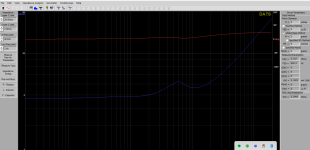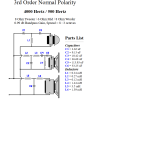So I started with XSIM for a 3-way project.
I just took a on-line calculator for filter and started to pluck in the components in XSIM.
Realized I didn´t set the drivers specs - allthough it looked fairly ok with 8 ohm setting.
I don't have the graphs on the driver and I don't seem to get the exact graphs I need from Dats V3 as show in this video for FP Graph Tracer.
So I wonder how do go about with Dayton Dats V3 to get the right curves and data I need to create accurate .zma and .frd files?
For now everything is really wacked when I put in what I have and can get out from Dats regardin .zma and .frd.
I just took a on-line calculator for filter and started to pluck in the components in XSIM.
Realized I didn´t set the drivers specs - allthough it looked fairly ok with 8 ohm setting.
I don't have the graphs on the driver and I don't seem to get the exact graphs I need from Dats V3 as show in this video for FP Graph Tracer.
So I wonder how do go about with Dayton Dats V3 to get the right curves and data I need to create accurate .zma and .frd files?
For now everything is really wacked when I put in what I have and can get out from Dats regardin .zma and .frd.
Attachments
The .zma files are associated with impedance response data, while .frd files are associated with SPL response data. The DATS test equipment only measures the impedance of a driver, noting that it measures both the magnitude response as well as the phase response. Both the magnitude and phase response of the impedance are required for accurate simulation of crossover networks in XSim.
To obtain the required .frd files, you will need to take SPL measurements of the drivers, using a microphone and software such as REW, ARTA, CLIO, etc. These will enable you to determine the required magnitude and phase responses of each driver when mounted on the speaker baffle.
It is possible to use FP Graph Tracer to trace a response curve. Usually, these are published in the driver manufacturer's datasheets. Note that FP Graph Tracer does not determine the minimum-phase phase response of a driver SPL or impedance from the magnitude response data that it traced. If you look at the third column of data in a file generated by FP Graph Tracer, you will see that it contains zeroes (0).
However, XSim has a feature whereby it can compute the minimum-phase phase response from the supplied magnitude response function. Keep that in mind when using .frd and .zma files created using FP Graph Tracer, as an extra step will be required somewhere along the way.
An alternative to FP Graph Tracer is the curve tracing feature that is in VituixCAD. The VituixCAD curve tracer can automatically compute the minimum-phase phase response, and the phase response is written to the .frd or .zma files when you save them appropriately.
To obtain the required .frd files, you will need to take SPL measurements of the drivers, using a microphone and software such as REW, ARTA, CLIO, etc. These will enable you to determine the required magnitude and phase responses of each driver when mounted on the speaker baffle.
It is possible to use FP Graph Tracer to trace a response curve. Usually, these are published in the driver manufacturer's datasheets. Note that FP Graph Tracer does not determine the minimum-phase phase response of a driver SPL or impedance from the magnitude response data that it traced. If you look at the third column of data in a file generated by FP Graph Tracer, you will see that it contains zeroes (0).
However, XSim has a feature whereby it can compute the minimum-phase phase response from the supplied magnitude response function. Keep that in mind when using .frd and .zma files created using FP Graph Tracer, as an extra step will be required somewhere along the way.
An alternative to FP Graph Tracer is the curve tracing feature that is in VituixCAD. The VituixCAD curve tracer can automatically compute the minimum-phase phase response, and the phase response is written to the .frd or .zma files when you save them appropriately.
Thank you @witwald
I suspected that I need to go that route with REW and microphone.
I need to invest in a mic since I often use second hand and older drivers. There is selldom data on them. Or new cheaper stuff without any curves from manufacturer.
I have a three way design now with a unknown tweeter from a slaughtered speaker that somone messed up, Dynaudio car-mid and Renkforce CPA6-75WM woofer that I have specs for but not any graphs or curves.
I suspected that I need to go that route with REW and microphone.
I need to invest in a mic since I often use second hand and older drivers. There is selldom data on them. Or new cheaper stuff without any curves from manufacturer.
I have a three way design now with a unknown tweeter from a slaughtered speaker that somone messed up, Dynaudio car-mid and Renkforce CPA6-75WM woofer that I have specs for but not any graphs or curves.

